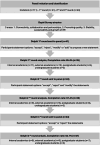The Creation of an Interprofessional Education (IPE) Strategy Utilising a Delphi Method
- PMID: 40320824
- PMCID: PMC12050908
- DOI: 10.1111/tct.70098
The Creation of an Interprofessional Education (IPE) Strategy Utilising a Delphi Method
Abstract
Background: Support for interprofessional education (IPE) is growing, with regulatory bodies requiring its inclusion in undergraduate healthcare programmes. Although the IPE Core Competencies and Guidelines offer principles for guiding IPE implementation, they lack practical application guidance. Bridging this gap necessitates tools to translate these frameworks into actionable practices. We developed an IPE strategy to overcome barriers by providing a clear roadmap to IPE implementation.
Method: The study designed a three-round E-Delphi. Initially, the research team created 24 strategic statements by consolidating existing IPE competencies. In Round 1, the panel could accept, reject, modify or add new statements. In Round 2, they could accept, reject or modify the revised statements. By Round 3, the panel either accepted or rejected the final statements. The research team analysed the levels of consensus, set at 80% agreement, and thematically analysed the free-text comments.
Findings: The Delphi panel consisted of 41 participants in Survey 1 and 43 in Surveys 2 and 3. The study began with 24 strategic statements across three priority areas. By the end of the Delphi process, this increased to 28 statements. Study consensus levels ranged from 74.29% to 100%, and participant retention rates were 85.4%, 67.4% and 62.7%, respectively.
Conclusion: The use of the E-Delphi method demonstrates its value in gathering diverse input, fostering consensus and enhancing the quality and relevance of IPE strategic development by integrating a broad range of perspectives. Further research on the scalability and long-term effects of this IPE strategy is warranted.
Keywords: E‐Delphi; collaboration; healthcare; interprofessional education; strategy.
© 2025 The Author(s). The Clinical Teacher published by Association for the Study of Medical Education and John Wiley & Sons Ltd.
Conflict of interest statement
The authors declare no conflicts of interest.
Figures
Similar articles
-
Using the modified Delphi technique to develop a framework for interprofessional education during international electives in health professions training institutions in Sub-Saharan Africa.Front Med (Lausanne). 2023 Oct 18;10:1225475. doi: 10.3389/fmed.2023.1225475. eCollection 2023. Front Med (Lausanne). 2023. PMID: 37920599 Free PMC article.
-
The next frontier: utilizing eLearning as an innovative approach to advance and sustain interprofessionalism.J Interprof Care. 2024 Jul-Aug;38(4):772-781. doi: 10.1080/13561820.2024.2345194. Epub 2024 May 9. J Interprof Care. 2024. PMID: 38722040
-
Interprofessional education in US radiologic technologist programs: Results of a national survey.J Med Imaging Radiat Sci. 2024 Sep;55(3):101325. doi: 10.1016/j.jmir.2023.09.003. Epub 2023 Oct 11. J Med Imaging Radiat Sci. 2024. PMID: 37833118
-
Delivery of interprofessional education through a co-curricular journal reviewing medical literature.Curr Pharm Teach Learn. 2022 Aug;14(8):1053-1059. doi: 10.1016/j.cptl.2022.07.019. Epub 2022 Aug 6. Curr Pharm Teach Learn. 2022. PMID: 36055696 Review.
-
Undergraduate-level teaching and learning approaches for interprofessional education in the health professions: a systematic review.BMC Med Educ. 2022 Jan 3;22(1):13. doi: 10.1186/s12909-021-03073-0. BMC Med Educ. 2022. PMID: 34980083 Free PMC article.
References
-
- “World Health Organization Framework for Action on Interprofessional Education & Collaborative Practice,” (Geneva, Switzerland: World Health Organization, 2010), http://apps.who.int/iris/bitstream/handle/10665/70185/WHO_HRH_HPN_10.3_e....
MeSH terms
Grants and funding
LinkOut - more resources
Full Text Sources
Miscellaneous


